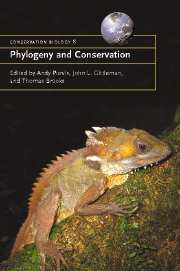Book contents
- Frontmatter
- Contents
- List of contributors
- 1 Phylogeny and conservation
- Part 1 Units and currencies
- Part 2 Inferring evolutionary processes
- 7 Age and area revisited: identifying global patterns and implications for conservation
- 8 Putting process on the map: why ecotones are important for preserving biodiversity
- 9 The oldest rainforests in Africa: stability or resilience for survival and diversity?
- 10 Late Tertiary and Quaternary climate change and centres of endemism in the southern African flora
- 11 Historical biogeography, diversity and conservation of Australia's tropical rainforest herpetofauna
- Part 3 Effects of human processes
- Part 4 Prognosis
- Index
- References
10 - Late Tertiary and Quaternary climate change and centres of endemism in the southern African flora
Published online by Cambridge University Press: 04 December 2009
- Frontmatter
- Contents
- List of contributors
- 1 Phylogeny and conservation
- Part 1 Units and currencies
- Part 2 Inferring evolutionary processes
- 7 Age and area revisited: identifying global patterns and implications for conservation
- 8 Putting process on the map: why ecotones are important for preserving biodiversity
- 9 The oldest rainforests in Africa: stability or resilience for survival and diversity?
- 10 Late Tertiary and Quaternary climate change and centres of endemism in the southern African flora
- 11 Historical biogeography, diversity and conservation of Australia's tropical rainforest herpetofauna
- Part 3 Effects of human processes
- Part 4 Prognosis
- Index
- References
Summary
INTRODUCTION
The high concentration of plant species in the winter rainfall region of southern Africa (Cowling 1992; Dean & Milton 1998) is an intriguing biogeographic pattern and one that has long eluded satisfactory explanation. This Mediterranean-climate region is home to two distinct vegetation types, the Fynbos and Succulent Karoo biomes, defined by their dominance by distinct plant structural types (Rutherford & Westfall 1986). Patterns of plant richness in both biomes reveal an island-like fingerprint of low family-level richness, but high species: genus ratios in relatively few speciose genera (Cowling 1992). High species-richness, levels of endemism and anthropogenic threat qualify both biomes as biodiversity hotspots, with the Succulent Karoo emerging as the only desert hotspot worldwide (Myers et al. 2000).
The Fynbos biome (sensu Rutherford & Westfall 1986) is a fire-prone vegetation assemblage dominated by short trees, fine-leaved shrubs and reed-like graminoids, and is found associated with generally nutrient-poor sandy soils of the mountains of the Cape Fold Belt and sandy coastal forelands. The conterminous Succulent Karoo (Rutherford & Westfall 1986) is drought-prone and dominated by short succulent-leaved shrubs, and to a lesser extent by evergreen small-leaved sclerophyll and deciduous small-leaved malacophyll shrubs. Grasses (Poaceae) are a minor component of both biomes (Gibbs Russel 1987).
- Type
- Chapter
- Information
- Phylogeny and Conservation , pp. 230 - 242Publisher: Cambridge University PressPrint publication year: 2005
References
- 9
- Cited by

